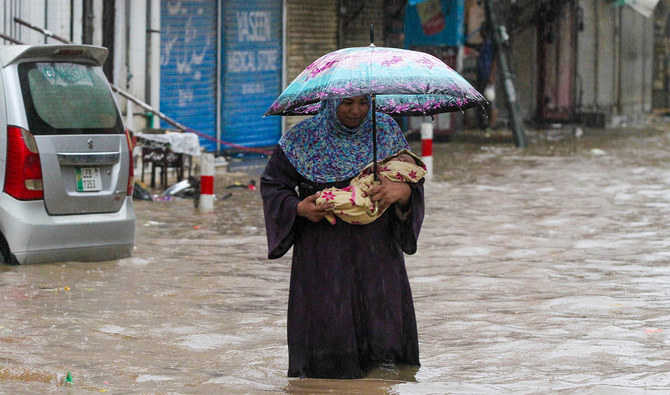LAHORE: Pakistan’s cultural city of Lahore saw record-high rainfall early Thursday, leaving at least three people dead, while flooding streets, disrupting traffic and affecting daily life, officials said, as the death toll from rain-related incidents over the past month surpassed 100.
In July, 99 people died in rain-related incidents and most of the deaths were reported in eastern Punjab and northwestern Khyber Pakhtunkhwa provinces, the National Disaster Management Authority said.
The latest spell of downpours started before dawn and is expected to continue for a week at intervals, according to the NDMA. In an advisory, it said the rains are likely to cause flash flooding and landslides.
The monsoon rains also lashed Pakistan’s capital, Islamabad, and other areas.
The latest spell of rains in Lahore was so heavy that it quickly flooded many streets and rainwater entered some wards in the Jinnah and Services hospitals in the capital of Punjab province, causing problems for patients undergoing treatment there.
At least one person died after being electrocuted in the Nishat Colony neighborhood. A 14-year-old boy drowned in a flooded street and a 5-year-old girl died after falling from the roof of her house, police said.
Some areas in the city received a record-high 353 millimeters (14 inches) of rainfall in a few hours, breaking a 44-year-old record in Lahore, according to the water and sanitation agency. In a statement, it said efforts were underway to pump rainwater off of main roads.
Drainage systems quickly became overwhelmed after the rains, flooding several residential areas, officials said. The rainwater entered scores of homes in various parts of the city, residents said.
Monsoon rains have returned to Pakistan as the country is still struggling to recover from devastating 2022 floods that affected 33 million people and killed 1,739. But weather forecasters say the country will receive less heavy rains compared to 2022, when climate-induced downpours swelled rivers.
Pakistan recorded its wettest April since 1961, with more than double the usual rainfall for the month. Weather forecasters and scientists have blamed climate change for the unusually heavy monsoon rains.
In neighboring Afghanistan, authorities on Thursday were dealing with a different kind of weather event, warning people against leaving their homes because of high temperatures.
Fawad Ayoubi, a forecast officer at the country’s aviation department, said people should go out before 10 a.m. and after 4 p.m. if they needed to leave the house.
“The temperature will increase in northern and northwestern provinces as well as southwestern provinces,” said Ayoubi. “The reasons are the monsoon or hot weather from India that is affecting Afghanistan.”
The World Health Organization also shared advice on how Afghans could protect themselves in the warmer weather. It said people should wear a wide-brimmed hat or hat and sunglasses, to eat small meals and more often, and to avoid leaving children in parked cars.


















